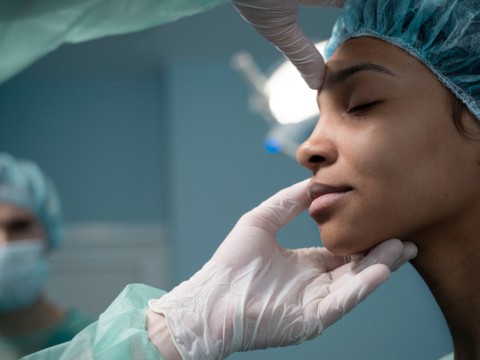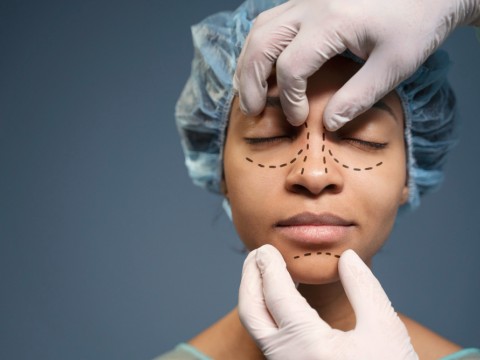Quote of Este Center
Rhinoplasty
Rhinoplasty, or nose surgery, is a popular cosmetic surgery to make one's nose more aesthetically pleasing and functional. This will include changes in the size and shape of the nose, the width of the nostrils, and the angle between the nose and the upper lip. Whether cosmetically or for breathing purposes, there's so much that rhinoplasty can offer to an individual who wants change.
Most people undergo rhinoplasty to restore their confidence and cosmetic facial balance. Since the nose is normally right in the middle of the face, its connotation might greatly influence the general aspect of the face. Any individual who might consider rhinoplasty should comprehend the procedure of surgery, its advantages, disadvantages, and implications after the operation.
What is Rhinoplasty?
Rhinoplasty is a surgical procedure performed to change the shape of one's nose. The surgery may be purely cosmetic-for changing the shape and/or size of the nose-or functional, where breathing is enhanced due to certain structural problems. Changes in bone and cartilage may be reshaped; tissue might be removed or added, as well as altering nostrils.
There are basically two types of rhinoplasty:
Open Rhinoplasty: this is performed by making an external incision on the columella, which is the soft tissue between the nostrils. This gives wider access to structures of the nose.
Closed Rhinoplasty: this involves making incisions on the inside of the nostril and leaves no marks visible subsequently.
Benefits of Rhinoplasty
The benefits of rhinoplasty can be numerous to improve appearance and function:
Aesthetic Enhancement: Most patients emerge feeling that facial symmetry and total aesthetics are grossly improved after rhinoplasty; therefore, generally increasing self-confidence.
Improvement in Breathing: Rhinoplasty can improve airflow, thus helping people with structural issues to deal with one's breathing problems.
Deformities: The procedure corrects the deformities attributed to injury, congenital conditions, or previous surgeries.
Customization: In rhinoplasty, one has the ultimate leeway to customize a nose to the shape desired but in tandem with features that will fit their face well.
Who is a Candidate for Rhinoplasty?
One may consider the following as candidates for undergoing a rhinoplasty:
Adults and Teens : Facial growth, usually is to be complete, around 15 in girls and 16 for boys, according to most surgeons
Healthy Individual: One should be in good health and needs to have realistic expectations of the results.
Discontentment with the Nose Appearance: Consider if one's nose detracts from the balance of the face or whether there are problems with its functioning.
It is essential to consult with a plastic surgeon to determine if one is a good candidate for the procedure and to establish realistic goals.
The Surgical Procedure
Most Rhinoplasties involve several stages, which can be performed as follows:
Consultation: A detailed examination is made by the surgeon, who informs about possible risks, medical history of the patient, and the goals of the latter.
Anesthesia: Rhinoplasty is usually performed under general anesthesia or sedation; this comforts the patient during surgery.
Incising and Re-molding: According to the technique adopted-open or closed- incisions are made, and reshaping of the bone and cartilages is done according to requirement.
Closing Incisions: After reshaping, incisions are closed, and a splint may be placed to support the new shape of the nose.
Recovery Process
The post-surgical work after rhinoplasty is the most important part for the best result:
Initial Healing: The patients frequently have swelling, ecchymosis, and pain, which normally peaks in the first few days.
Post-Operative Instructions: Compliance with the surgeon's activity limitations, medications, and wound care is advantageous for the optimal healing of the wound.
Follow-up Visits: Regular follow-ups are helpful in monitoring the healing process and also for voicing concerns.
Full Recovery: The majority of areas of swelling have diminished within weeks, while the remainder usually takes a year or more post-operation for them to disappear completely.
Possible Side Effects and Complications
Rhinoplasty is a generally safe operation, but as in any other surgical intervention, some possible side effects and complications should be taken into consideration:
Infection: As with any other surgical intervention, infection can occur at the site of incision after rhinoplasty.
Scars: Open rhinoplasty will result in visible scars; however, skilled surgeons do their best to make them as minimal as possible.
Impaired Breathing: Sometimes, nasal breathing may be impaired and last for some time after the operation.
Dissatisfaction with Aesthetic Outcome: There is always a risk that one will not achieve the desired aesthetic outcome, which is well underscored through ample communication with the surgeon.
Rhinoplasty is an effective option for those people who intend to improve their look and enhance the function of their nose. In other words, by understanding the procedure, the benefits and risks, prospective candidates will have a recovery that allows them to make educated decisions regarding their treatment. If one is considering rhinoplasty, it is best to consult with a qualified plastic surgeon to discuss your goals and come up with an individualized plan. With the right approach and expert guidance, it is possible to get that kind of nose you always wanted and feel a surge in confidence and self-esteem.
- Abdominal liposuction
- Arm Lift (Brachioplasty)
- Back Liposuction
- Blepharoplasty (Eyelid Surgery)
- Brazilian Butt Lift (BBL)
- Breast Augmentation
- Breast Augmentation with Tear Drop Implants
- Breast Correction
- Breast Implant Removal
- Breast Implants With Breast Lift
- Breast Lift
- Breast Reconstruction
- Breast Reduction
- Brow Lift
- Buccal Fat Extraction
- Butt Implants
- Buttock lift
- Buttock Reduction
- Cheekbone Reduction
- Chin Implant
- Health Insurance
-
Accommodation
- Online Healthy Life Assistant 9/5
- Post - Experience Follow Up 6 Month
-
Extra Privileges
- Transfer

- Health Insurance
-
Accommodation
- Online Healthy Life Assistant 24/7
- Post - Experience Follow Up 1 Year
- Pre-Treatment Doctor Consultation
-
Extra Privileges
- Transfer

 Private
Private
- Health Insurance
- Healthy Life Butler
- Post - Experience Follow Up 2 Year
- World-Famous Doctor Consultation
-
Extra Privileges
No suitable hotel found for the relevant dates!
* Price varies depending on extra and upgrade selections.
Plastic surgeries for nose are applied to everyone if they don’t have different health condition that hinder the surgery. For example, If you have a bleeding disorder, such as hemophilia, you may not be a candidate for rhinoplasty. The recommended minimum age for the procedure is typically 18 years old. This age is advised because, by 18, the nasal bone has usually fully grown, providing a more stable foundation for the surgery. However, in exceptional cases where there is a breathing impairment or other significant issues, the surgery may be considered at a younger age. The decision in such cases is typically based on the individual's specific medical needs and circumstances.
After undergoing rhinoplasty surgery, especially in the first 24 hours, you might experience some puffiness in your face, nose discomfort, and a mild headache. These are normal side effects and can be managed with pain medication. Both internal and external dressings are removed within 5-7 days. Avoid using eyeglasses or sunglasses on your nose for at least four weeks to prevent pressure. Most individuals can return to work within a week to ten days. Steer clear of strenuous exercise and contact sports for six weeks to safeguard your nose from potential injury. The new shape of your nose becomes more evident in the second week as the swelling, edema, and dark circles begin to diminish. The true transformation becomes apparent around the third month.
Rhinoplasty is generally not a painful surgery. Most people can resume their normal activities a week after the procedure. After the rhinoplasty you may experience mild pain which can be managed with painkillers.
The use of tampons in nasal surgeries is a common concern for many people. Nowadays, classic tampons are rarely used in plastic surgeries. Instead, silicon tampons are typically employed. Silicon tampons serve as a barrier between the inner and outer walls of the nose, preventing the formation of adhesions. Unlike traditional tampons, silicon tampons are soft and flexible, making their removal from the nose easy and painless.
Nose job is a surgical operation and the results are permanent.
One such option is a temporary nonsurgical nose job, often referred to as liquid rhinoplasty. Liquid rhinoplasty is a temporary solution addressing concerns like a dorsal hump, a drooping nasal tip, or asymmetry. This procedure should be performed by a skilled plastic or facial plastic surgeon. Typically, liquid rhinoplasty utilizes hyaluronic acid-based injectable fillers, the same type commonly used for cheek and lip enhancements. The procedure is quick, taking approximately 20 minutes, and the effects last between 6 to 18 months.
Although you will experience a loss of smell right after your rhinoplasty, it is important to remember that this loss is only temporary. Any smell loss is usually temporary and resolves within a few weeks.
Yes, rhinoplasty can address functional issues in addition to cosmetic concerns. Procedures such as septoplasty or turbinate reduction can be incorporated to improve nasal airflow and alleviate breathing difficulties.
In most cases, rhinoplasty is performed using incisions inside the nose (closed rhinoplasty) or with a small external incision on the columella (open rhinoplasty). Scarring is minimal and often not visible, especially with closed rhinoplasty.





